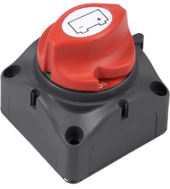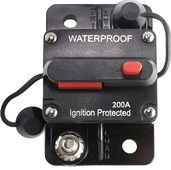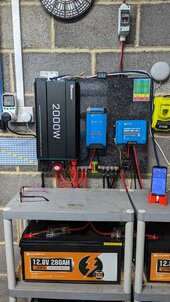You are using an out of date browser. It may not display this or other websites correctly.
You should upgrade or use an alternative browser.
You should upgrade or use an alternative browser.
Fuse and Isolator alternative?
- Thread starter Beavo
- Start date
Hedges
I See Electromagnetic Fields!
- Joined
- Mar 28, 2020
- Messages
- 20,916
None at all - if you can find a "UL" listing on that breaker, and if 200A OCP is suitable substitute for 30A OCP, and if voltage and AIC rating are high enough.
Those no-name breakers are highly suspect. Good brand names are available.
They are thermal only, slow trip. The fuse will fast blow at some current above 5x its rating. Quality breakers are also available with magnetic fast trip. My new love is magnetic-hydraulic breakers, rather than the thermal-magnetic I've used before.
By the way, if you want a precharge circuit, some rotary switches are available with off-on-on configuration, convenient to implement it with a resistor.
Those no-name breakers are highly suspect. Good brand names are available.
They are thermal only, slow trip. The fuse will fast blow at some current above 5x its rating. Quality breakers are also available with magnetic fast trip. My new love is magnetic-hydraulic breakers, rather than the thermal-magnetic I've used before.
By the way, if you want a precharge circuit, some rotary switches are available with off-on-on configuration, convenient to implement it with a resistor.
FilterGuy
Solar Engineering Consultant - EG4 and Consumers
A couple points.
1) Be sure to only buy name brand on that style breaker. (Blue Sea is a good brand) The knock-offs are notorious for being dangerous.
2) The ANL fuse has a very low AIC rating. It is generally accepted that the main battery fuse needs a class T fuse with the 20KA AIC. (There is some debate about whether 20KA is needed but not much debate that at least 10KA is needed for a single battery and 20KA is need for parallel batteries.
3) I don't know what the AIC of the breaker is, but that should be checked.
1) Be sure to only buy name brand on that style breaker. (Blue Sea is a good brand) The knock-offs are notorious for being dangerous.
2) The ANL fuse has a very low AIC rating. It is generally accepted that the main battery fuse needs a class T fuse with the 20KA AIC. (There is some debate about whether 20KA is needed but not much debate that at least 10KA is needed for a single battery and 20KA is need for parallel batteries.
3) I don't know what the AIC of the breaker is, but that should be checked.
A couple points.
1) Be sure to only buy name brand on that style breaker. (Blue Sea is a good brand)
Blue Sea only seem to go up to 150 amps with surface mounts and their website is painful to navigate on a phone.
Are there any other reliable manufacturers that make a 200 amp version?
Cheers
None at all - if you can find a "UL" listing on that breaker, and if 200A OCP is suitable substitute for 30A OCP, and if voltage and AIC rating are high enough.
Sorry, I'm new to the forum and haven't picked up the lingo yet.
I understood the "None at all" bit.
I didn't understand anything after that.
Thanks anyway.
Andrewr05
[Replicant 42069]
UL is Underwriters Laboratories.Sorry, I'm new to the forum and haven't picked up the lingo yet.
I understood the "None at all" bit.
I didn't understand anything after that.
Thanks anyway.
They do testing on products to make sure that they meet minimum safety protocols in order to be used in the USA, at least correctly.
That isn't to say that there aren't products out there that aren't UL certified that probably won't be "good enough" but for serious installs (especially something that needs to be inspected by an electrician) you likely can't legally use anything at all that isn't UL listed.
OCP = Over Current Protection
AIC = Amperage Interrupt Current
That device you posted is called a MRCB (Marine Rated Circuit Breaker) and it's a close of a Bussmann unit.
Hedges
I See Electromagnetic Fields!
- Joined
- Mar 28, 2020
- Messages
- 20,916
The fuse and the disconnect switch have a number of ratings. So do breakers.
Fuse: Amps, voltage, AIC (ability to open with high current short circuit) which varies with voltage, current/time curve.
Switch: Current, voltage, whether it can interrupt current or only be opened with zero current.
Breaker, both of above.
What is your system voltage? What battery do you have?
Lithium batteries can deliver massive current, may cause a fuse/switch/breaker to draw an arc and burn. When connected to an inverter, which has capacitors, a brief surge of several thousand amps and damage things.
You need full specs for all the involved parts to determine if the work together.
Fuse: Amps, voltage, AIC (ability to open with high current short circuit) which varies with voltage, current/time curve.
Switch: Current, voltage, whether it can interrupt current or only be opened with zero current.
Breaker, both of above.
What is your system voltage? What battery do you have?
Lithium batteries can deliver massive current, may cause a fuse/switch/breaker to draw an arc and burn. When connected to an inverter, which has capacitors, a brief surge of several thousand amps and damage things.
You need full specs for all the involved parts to determine if the work together.
Andrewr05
[Replicant 42069]
Here's a 200a rated version-
 www.bluesea.com
www.bluesea.com
187-Series Circuit Breaker - Surface Mount 200A - Blue Sea Systems
Thermal circuit breakers provide heavy duty circuit protection for 25 to 200 Amp loads when switching and circuit protection are both required.
Hedges
I See Electromagnetic Fields!
- Joined
- Mar 28, 2020
- Messages
- 20,916
Blue Sea only seem to go up to 150 amps with surface mounts and their website is painful to navigate on a phone.
Are there any other reliable manufacturers that make a 200 amp version?
Cheers
Get on a computer. Easier to use a mouse, save links and screenshot or print to files. Draw schematics, etc.
Blue Sea has good stuff, as does Midnight Solar. Some breakers are in a different format, DIN rail or bolt mount, and have higher rating and additional capabilities beyond those flat thermal breakers.
For a small 12V system, brand name breakers of that format may be sufficient.
Photos, part numbers, links to data sheet are useful for people to help. That includes your existing equipment, not just the protection devices.
Hedges
I See Electromagnetic Fields!
- Joined
- Mar 28, 2020
- Messages
- 20,916
Here's a 200a rated version-
187-Series Circuit Breaker - Surface Mount 200A - Blue Sea Systems
Thermal circuit breakers provide heavy duty circuit protection for 25 to 200 Amp loads when switching and circuit protection are both required.www.bluesea.com
"
| Maximum Voltage | 48V DC |
"
Interrupt Capacity

| 5000A @ 14VDC 3000A @ 28VDC 1500A @ 48VDC |
(Note that doesn't mean a 48V nominal battery, rather one that never exceeds 48V, e.g. 36V nominal.)
Compare interrupt capacity to short-circuit current your battery can deliver.
A 100 Ah 12V AGM battery can deliver 4000A. Lithium, I think much more.
So we prefer higher performance fuses and breakers.
Hedges
I See Electromagnetic Fields!
- Joined
- Mar 28, 2020
- Messages
- 20,916
12V system, you can get away with a lot more. But I do think LiFePO4 batteries could deliver high short circuit current if BMS failed.
So I'd prefer an expensive breaker, or a fuse. Be sure to use appropriate fuse holder. In particular for MRBF which looks like it could bolt directly to battery, but I think that would bypass/short the fuse.
 www.bluesea.com
www.bluesea.com
 www.bluesea.com
www.bluesea.com
 www.bluesea.com
www.bluesea.com
So I'd prefer an expensive breaker, or a fuse. Be sure to use appropriate fuse holder. In particular for MRBF which looks like it could bolt directly to battery, but I think that would bypass/short the fuse.
ANL Fuse - 200 Amp - Blue Sea Systems
Use with ANL Fuse Blocks for many applications with 35-750 Amp loads
MRBF Terminal Fuse - 200A - Blue Sea Systems
Space-saving ignition protected fuse for 30 to 300 Amp loads. Must use with Terminal Fuse Block.
Fuse A3T / Class T 200 Amp - Blue Sea Systems
Use with Class T Fuse Blocks for circuit protection of devices including inverters. high interrupt capacity for large battery banks including Lithium-ion and TPPL batteries.
Thank you very much for taking the time to do that.12V system, you can get away with a lot more. But I do think LiFePO4 batteries could deliver high short circuit current if BMS failed.
So I'd prefer an expensive breaker, or a fuse. Be sure to use appropriate fuse holder. In particular for MRBF which looks like it could bolt directly to battery, but I think that would bypass/short the fuse.
ANL Fuse - 200 Amp - Blue Sea Systems
Use with ANL Fuse Blocks for many applications with 35-750 Amp loadswww.bluesea.com
MRBF Terminal Fuse - 200A - Blue Sea Systems
Space-saving ignition protected fuse for 30 to 300 Amp loads. Must use with Terminal Fuse Block.www.bluesea.com
Fuse A3T / Class T 200 Amp - Blue Sea Systems
Use with Class T Fuse Blocks for circuit protection of devices including inverters. high interrupt capacity for large battery banks including Lithium-ion and TPPL batteries.www.bluesea.com
Cheers
Similar threads
- Replies
- 14
- Views
- 646






